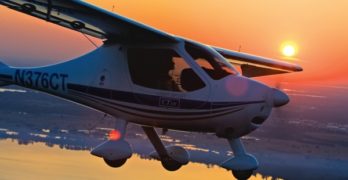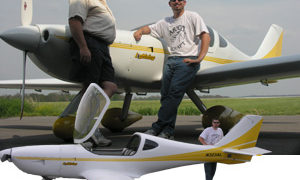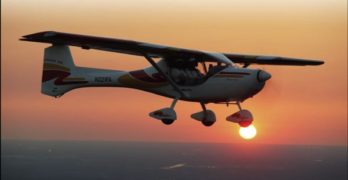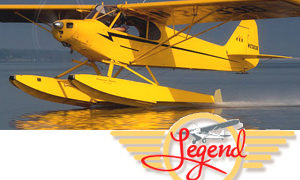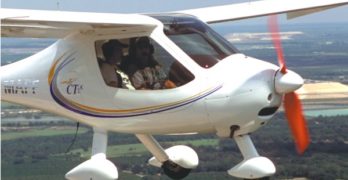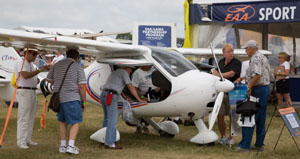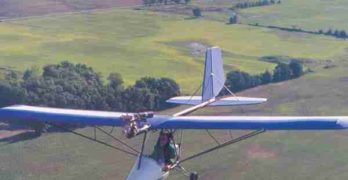In the 15 months since the first two special light-sport aircraft (S-LSA) were introduced
at the Sun ‘n Fun Fly-In in Lakeland, Florida, a wave of S-LSA have taken to the
sky. The number delivered to customers is approaching 500 aircraft — and climbing as
quickly as factories can produce and deliver them. The years ahead should see a sharply
increasing number of LSA flying in America.
The good news for pilots is we won’t
just have more LSA, we’ll have better
ones as designers modify and improve
aircraft based on customer input and
service history. That’s one of the benefi
ts of consensus standards versus
type certification-manufacturers
can cram more features into the airplanes
and factories may refine production
techniques without undergoing
costly recertification. The best
news is we don’t have to wait. “New
and improved” LSA are here now.
The 2006 CT
Because of its distinctive profile, the
Flight Design CT is one of the most
recognized S-LSA flying.
Search Results for : flight design ct
Not finding exactly what you expected? Try our advanced search option.
Select a manufacturer to go straight to all our content about that manufacturer.
Select an aircraft model to go straight to all our content about that model.
Aircraft Design Holy Grail…& Arion’s Lightning
A standard measuring stick for aircraft design is the ratio of minimum speed to maximum speed. Powerful jets like the Blue Angels’ F/A-18 (along with a government credit card to fuel them) can perform in airshows from 120 mph to 700 mph, almost a 6:1 ratio. But for airplanes you and I can afford, a ratio greater than 3:1 is good with 4:1 being the holy grail. In my experience, a 4:1 ratio is rare; a LSA that stalls at 40 knots and tops out at 120 knots represents only 3:1. *** Recently I flew the Arion Aircraft Lightning. Yielding a fine experience with quick yet stable handling, short takeoffs and easy landings plus mild stalls, Lightning also proved a handsome performer. Nick Otterback reports flying Lightning to better than 200 mph and I held around 40 mph in slow flight. Even assuming instrument error at slow speeds, that’s still well beyond the 4:1 ratio.
An Introduction to Light-Sport Aircraft
Sport pilot and light-sport aircraft,
what’s it all about?
If you’ve ever thought about
learning to fly, returning to
flying, or resuming flying lessons
that you started years ago,
congratulations; your timing is
just about perfect! This rule provides
new opportunities for you as well as
anyone who has dreamed of owning
an aircraft.
This article will summarize how
SP/LSA affects you. We’ll keep it simple;
when you’re ready for more,
EAA offers many ways to become
more informed (see “For More
Information”). Like many activities,
flying has its own language with
abbreviations, acronyms, forms, and
numbers to make discussing it faster.
Veteran pilots throw this lingo around
casually and often baffle those who
aren’t involved. We’ll avoid such jargon
in this article, and we’ll only use
abbreviations after we’ve explained
them.
Let’s Get Started!
SP/LSA has two basic components:
“Sport pilot” refers to a new pilot
certificate you can earn (the FAA calls
them certificates as opposed to licenses);
“Light-sport aircraft (LSA)” refers
to a new category of aircraft.
U.S. Leading Manufacturer of LSA Remains a Legend
With the delivery of their 88th Legend Cub, the Sulphur Springs, Texas-based company handily confirmed its well-out-in-front leadership among American companies building SLSA. If fact, among the entire fleet, Legend is a solid number two behind Flight Design and its CT, a good margin ahead of next-best producers Fantasy Air, TL Ultralight, Evektor, Tecnam, and AMD (according to the best info I have). Other U.S. built LSA companies include IndUS, RANS, Jabiru USA, CubCrafters, Skykits, Just Aircraft, Luscombe, Prestige, Delta Jet (trike), and Infinity (PPC). Seventeen models — a shade over a third — of 48 currently approved are either “Made in the USA” or foreign designs built in the U.S. *** All-American Legend recently listed their many achievements in less than two years since the first SLSA approvals including: Jabiru (or Continental) power, floats, glass cockpit, special paint schemes…all in addition to many Piper J-3 improvements, such as a wider cockpit, doors on both sides, and fly from either seat capability.
Composite Two-seater (CT)
In the fall of ’01, I wrote in Ultralight Flying!, “The CT is the tip of an iceberg, in my opinion.” When I flew that first CT in the USA, few Yankees had seen the aircraft. I felt the German design represented the beginning of a flow of European aircraft coming to America. What a difference a couple of years make!
Thanks to adept and steady promotion, Americans may best identify the coming breed of proposed Light-Sport Aircraft by pointing to the Flight Design CT2K. While this means no disrespect to trikes, tube-and-rag ultralights, or powered parachutes, the CT’s unusual, smoothly-contoured shape is now well known to many Americans. Though the brand is fabricated in the Ukraine and assembled in Germany, it crosses the Atlantic as a prototypical candidate for FAA’s proposed Light-Sport Aircraft category.
Rollison Light Sport Aircraft imported the first U.S.-based CT I flew. The design is now brought in by Flightstar Sportplanes and HPower HKS engine honcho Tom Peghiny.
Flight Design Surveys Sport Pilots; Offers Prizes
I hope you enjoyed your Labor Day holiday. Over this long weekend Randee and I headed to Boston for the EAA Sport Pilot Tour on Sept. 9th. At that event, visitors can complete a survey. Not only is it a chance to tell the leading seller of LSA what type of aircraft you want, but you can win some handsome prizes. Winners will be randomly chosen from those who participate in the survey. Your odds are very good to win First Prize which is a Garmin 396 worth $2,395. Second prize is a King Schools Sport Pilot Training Course and third prize is a Composiclean composite aircraft cleaning supply set. Taking the survey costs you nothing and you don’t have to go to Boston. Just click here and complete 9 multiple choice questions. (You can also add a comment.) *** But, you must act soon.
Product Lines – April 2005
ST. PAUL, MINN. – Here’s an interesting perspective on the World Meet in Hay. The
missing Manfred (Ruhmer) saw the event in his own way and expressed himself
clearly. He didn’t go|which also means somebody else got to win after Manfred has
won the last two World Meets. In the fifteen World meets that have been held since
1976, only one man has achieved more. Tomas Suchanek won the event three times
running, a record. Looking at the history of hang gliding’s
main worldwide competition, a New Zealand pilot unknown to most Americans, Terrence
Delore, won the first event. He was followed by Josef Guggenmos, the talented
German wing designer (’79); by Brazilian Padro Paulo Lope (’81); by famous Australian
Steve Moyes (’83); by British legend John Pendry (’85); by another Australian
Rick Duncan, now a partner in AirBorne (’88); by Robert Whittall who also
went on to paragliding competition fame (’89); and then three times in a row by Czech
pilot Tomas Suchanek (’91, ’93, and ’95); by German Guido Gehrmann (’98); twice by
Manfred (’99 and ’03); and now by Ukrainian star, Oleg Bondarchuk (’05).
Product Lines – February 2005
ST. PAUL, MINN. — As this issue went to press, the Christmas cards and calls were
arriving as usual. One call was a flashback to precisely two years ago, when in this
column (Feb. ’03) I wrote a farewell to longtime Hang Gliding editor, Gil
Dodgen. So, perhaps it was fitting that he should call recently.
Gil was charged up over a big success by his employer of the last couple years. Vertigo
is an aviation and defense developer and they’d just done a specialized parachute
drop that hit the target perfectly. The SoCal company creates solutions and has found
answers when others couldn’t to create a successful enterprise. This is no surprise
as Vertigo has quite a brain trust so the addition of software writer Dodgen was
quite appropriate. In addition to Glen Brown, who you may not know, Vertigo’s staff
is “hang gliding heavy.” Brown’s founding partner is CEO Roy Haggard whose
most notable hang gliding claim to fame was developing the UP Comet, a glider
widely believed to have forever changed the design of hang gliders.
Flightstar Classic
A great old name has returned! The Flightstar is back. Actually, the design has survived various ownership changes quite well. The original Pioneer Flightstar became the Argentine Aviastar. Now original designer, Tom Peghiny, has bought the plane and the name.
It’s all-American again, too, made in the USA. Above you see the F.A.R. Part 103-legal version, the Flightstar Classic. The Classic has a big brother single seater and of course, a two-seat trainer. The Classic is the company’s primary fun machine, though.
All the Flightstars were designed under accepted engineering methods. They’ve also been given the touch by Peghiny, an ultralight pioneer who aviation business experience dates back to his teens. It’s easy to see this successful combination if you examine individual component design and finish.
The Flightstar has an avid following of five hundred owners who love the way their planes fly. The Classic has simple features and low price while maintaining wonderful handling qualities.
Product Lines – December 2004
WALLABY RANCH, FL — While northerners prepare for winter and snow, it’s hot and
sunny here in Florida. I’m in the state for a collection of aviation events, kicked
off by a big gathering at Malcolm Jones’ “Ranch.”
They called it the Moyes Boys Reunion. When most of us hear “reunion” we think
of Class Reunions, and many groan about having to attend. Since I similar gatherings
like Dockweiler and Grandfather Mountain, I was pleased to make this one. I saw old
friends I hadn’t seen in 20+ years. But what really moved me was meeting John
Dickenson, who may have been THE man who invented the hang glider as we
know it today. John taught both Bill Moyes and Bill Bennett
to fly “ski kites” as they were then called. Moyes went on to become a major brand
name. Bill Bennett once directed a leading company that gave Bob Wills his start
in the business.
- « Previous Page
- 1
- …
- 21
- 22
- 23
- 24
- 25
- …
- 145
- Next Page »


